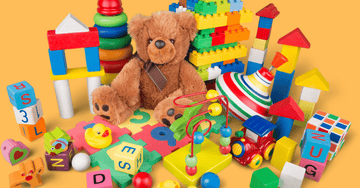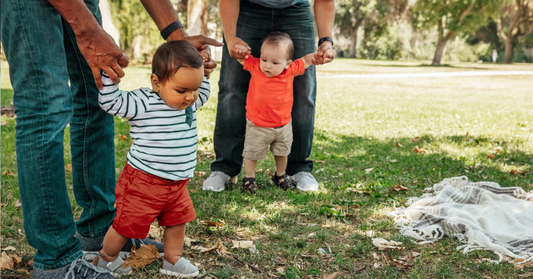Wann fangen Babys an, ? zu kriechen

Babys beginnen im Allgemeinen zwischen sechs und zehn Monaten zu krabbeln, wobei jedes Kind einen individuellen Weg geht. Indem Sie Ihrem Kleinen täglich Zeit auf dem Bauch lassen, Spielzeuge außerhalb seiner Reichweite platzieren und Ihr Zuhause kindersicher machen, können Sie ihm helfen, seine Muskeln zu stärken, seine Koordination zu trainieren und die Welt um sich herum sicher zu erkunden.
1. Einleitung
„Babys beginnen normalerweise im Alter zwischen sechs und zehn Monaten zu krabbeln, aber man darf nicht vergessen, dass sich jedes Baby nach seinem eigenen Zeitplan entwickelt. Indem sie eine sichere, behütende Umgebung schaffen und es zu Bewegung anregen, können Eltern das ganzheitliche Wachstum ihres Babys fördern und die Grundlage für erfolgreiches Krabbeln legen“, Kevin Kathrotia, ein Neonatologe und Kinderarzt der Millennium Medical Group (USA), erklärt.
Krabbeln ist nicht nur eine Methode, sich fortzubewegen – dieser Meilenstein fördert auch Muskelkraft, Gleichgewicht, räumliches Vorstellungsvermögen und Problemlösungsfähigkeiten. In diesem Artikel werden wir untersuchen, wann und wie Krabbeln normalerweise stattfindet, die verschiedenen Krabbelarten, Tipps, die Ihrem Kleinen den Einstieg erleichtern, und Möglichkeiten, wie Sie es sicher halten können, während es die Welt aus einer völlig neuen Perspektive erkundet.
2. Wann beginnen Babys zu krabbeln?
Die meisten Babys beginnen zwischen sechs und zehn Monaten zu krabbeln, manche beginnen jedoch früher oder brauchen etwas länger. Die Krabbelerfahrung jedes Kindes ist einzigartig und wird von Faktoren wie Muskelkraft, genetischer Veranlagung und der Häufigkeit des Krabbelns beeinflusst. Zeit auf dem Bauch.
Durchschnittliche Altersspanne
• Im Alter von etwa vier bis sechs Monaten zeigen Babys meist erste Anzeichen von Mobilitätsversuchen, die sich darin äußern können, dass sie sich häufiger auf dem Bauch rollen.
• Im Alter von sechs bis zehn Monaten beginnen viele Babys mit den ersten Phasen des Krabbelns. Es ist jedoch nicht ungewöhnlich, dass einige Babys erst mit elf oder zwölf Monaten damit beginnen.
Einflussfaktoren
• Genetische und körperliche Bereitschaft: Kinder erben natürliche Unterschiede im Muskeltonus und der Koordination.
• Zeit auf dem Boden: Babys, die gerne auf dem Boden spielen und auf dem Bauch liegen, entwickeln oft früher die Muskelkraft und das Selbstvertrauen zum Krabbeln.
• Allgemeine Gesundheit und Ernährung: Die richtige Ernährung und regelmäßige Kontrolluntersuchungen beim Kind sind für eine normale Entwicklung von entscheidender Bedeutung.
Eltern beruhigen
• Wenn Ihr Baby länger zum Krabbeln braucht, muss das nicht unbedingt ein Anzeichen für eine Entwicklungsstörung sein. Manche vollkommen gesunden Babys überspringen das Krabbeln und beginnen direkt mit dem Laufen.
• Bleiben Sie geduldig und konzentrieren Sie sich darauf, dass das Wachstum Ihres Kindes in einem für es angenehmen Tempo erfolgt.
3. Was sind die Phasen und Arten des Krabbelns?
Bevor Babys das bekannte Krabbeln auf Händen und Knien beherrschen, können sie auf dem Bauch rutschen, auf dem Rücken krabbeln oder sogar auf dem Po krabbeln. Diese Variationen sind ein normaler Lernprozess und helfen ihnen, die Kraft und Koordination zu entwickeln, die sie brauchen, um schließlich selbstbewusst zu krabbeln.
Häufige Krabbelphasen
- Bauchrutschen: Babys benutzen ihre Arme, um ihren Bauch auf glatten Oberflächen nach vorne zu ziehen.
- Army/Commando Crawl: Sie liegen auf dem Bauch, stützen sich auf die Unterarme und ziehen sich nach vorne.
- Schaukeln auf Händen und Knien: Babys stemmen sich auf Händen und Knien hoch und schaukeln vor und zurück, wodurch sie Muskeln aufbauen und ihre Koordination verbessern.
- Klassisches Krabbeln auf Händen und Knien: Traditionelles Krabbeln, bei dem zur Vorwärtsbewegung sowohl die andere Hand als auch das andere Knie gleichzeitig angehoben werden.
Verschiedene Krabbelstile
• Bärengang: Babys halten ihre Arme und Beine gerade, anstatt die Knie zu beugen.
• Krabbengang: Sie bewegen sich seitwärts statt geradeaus.
• Rollen: Manche Babys rollen, um von einem Ort zum anderen zu gelangen. Manchmal geht der Übergang später nahtlos in das Krabbeln über.
Bedeutung der einzelnen Phasen
• Entwicklung der Rumpfkraft: Jede Methode und Phase hilft, den Rumpf und die Gliedmaßen zu stärken.
• Koordination stärken: Durch die Gewichtsverlagerung zwischen Armen und Beinen wird das Gleichgewicht trainiert.
• Räumliches Bewusstsein: Durch selbstständige Bewegungen lernen Babys, Entfernungen und die Platzierung von Gegenständen zu verstehen.
4.Woher weiß ich, dass mein Baby bereit ist zu krabbeln?
Anzeichen dafür, dass Ihr Baby bereit ist, sind Kopf- und Nackenkontrolle, Schaukeln auf allen Vieren und ein wachsender Wunsch, Objekte außerhalb der Reichweite seiner Arme zu erkunden. Wenn Sie bemerken, dass Ihr Baby sich beim Liegen auf dem Bauch selbstbewusster hochdrückt, ist das ein deutliches Zeichen dafür, dass es sich auf das Krabbeln vorbereitet.
Körperliche Anzeichen
• Stabile Kopf- und Nackenkontrolle: Babys sollten ihren Kopf ohne Schwierigkeiten heben und drehen können.
• Effizientes Umdrehen: Der Wechsel zwischen Rücken- und Bauchlage deutet auf den Aufbau der Rumpfmuskulatur hin.
• Mini-Liegestütze: In der Bauchlage können sich Babys mit den Armen hochdrücken, um die Welt um sich herum zu sehen.
Verhaltensindikatoren
• Nach Spielzeug greifen: Sie versuchen, nach Objekten zu greifen, die leicht außerhalb ihrer Reichweite liegen, was sie dazu veranlasst, sich zu bewegen.
• Ständiges Schaukeln: Vor- und Zurückschaukeln auf Händen und Knien zeigt die Bereitschaft der Muskeln.
• Drehen auf der Stelle: Das Drehen des Körpers in der Bauchlage ist ein Zeichen für den Aufbau von Kraft und Flexibilität.
Möglichkeiten zur Förderung von Aktivitäten vor dem Krabbeln
• Zeit auf dem Bauch: Wenn Sie Babys auf den Bauch legen, können sie üben, ihren Kopf und ihre Arme zu heben.
• Interaktives Spielen: Beschäftigen Sie sie mit Spielzeugen, Spiegeln und bunten Objekten, die sie dazu anregen, sich zu bewegen.
• Unterstützte Positionierung: Führen Sie die Arme und Beine Ihres Babys beim Spielen sanft in eine Krabbelhaltung.
5. Wie kann ich meinem Baby das Krabbeln beibringen?
Sie können die Krabbelfähigkeiten Ihres Babys fördern, indem Sie ihm regelmäßig Zeit auf dem Bauch lassen, interessante Gegenstände außerhalb seiner Reichweite platzieren und jeden Versuch, sich vorwärts zu bewegen, mit Lob belohnen.
Bewährte Methoden für die Zeit auf dem Bauch
• Häufigkeit und Dauer: Streben Sie mehrere kurze Sitzungen auf dem Bauch am Tag an und erhöhen Sie die Dauer allmählich, wenn sich Ihr Baby wohler fühlt.
• Sichere Positionierung: Beaufsichtigen Sie Ihr Baby immer und bieten Sie ihm eine weiche, saubere Fläche zum Bewegen.
• Spaßiges Engagement: Lenken Sie ihre Aufmerksamkeit durch sanftes Reden, Spielzeug mit hohem Kontrast, oder verspielte Musik.
Bewegung fördern
• Spielzeug und Spiegel: Platzieren Sie anregende Gegenstände etwas außerhalb der Reichweite und motivieren Sie Ihr Kind, sich zu strecken und vorwärts zu gehen.
• Positive Verstärkung: Babys gedeihen durch Ermutigung – lächeln, klatschen und loben ihre kleinsten Erfolge.
• Passen Sie es so an, dass es sich angenehm anfühlt: Wenn Ihr Baby unruhig wird, bewegen Sie es sanft oder bieten Sie ihm eine kurze Pause an. Versuchen Sie es dann später erneut.
Techniken & Übungen
• Rumpfunterstützung: Legen Sie ein aufgerolltes Handtuch unter die Brust, um sanfte Unterstützung zu bieten, während Ihr Kind lernt, sein Gewicht auf die Arme zu verteilen.
• Demonstration: Manchmal kann das Vorführen der Bewegung sie inspirieren – krabbeln Sie ein wenig über den Boden, um ihnen zu zeigen, wie es geht.
6. Wie kann ich die Sicherheit meines Babys gewährleisten, während es krabbeln lernt?
Durch wirksame Kindersicherungen, bei denen Sie beispielsweise kleine Gegenstände vom Boden räumen, Steckdosen abdecken und Möbel sichern, kann Ihr kleiner Entdecker sicher umherstreifen, während er diese neue Form der Mobilität lernt.
Wichtige Hinweise zur Babysicherung
• Treppenschutzgitter und Gefahrenbarrieren: Installieren Sie Schutzgitter am oberen und unteren Ende von Treppen sowie in der Nähe von Bereichen ohne direkte Aufsicht.
• Sichern Sie Möbel: Verankern Sie Bücherregale, Kommoden und Fernseher an der Wand, um ein Umkippen zu verhindern.
• Steckdosen und Kabel abdecken: Verwenden Sie kindersichere Steckdosenabdeckungen und bewahren Sie Elektrokabel außerhalb der Reichweite auf.
Überwachung und Aufsicht
• Ständige Wachsamkeit: Babys können in Sekundenbruchteilen von stiller zu beweglicher Haltung wechseln. Bleiben Sie in der Nähe, insbesondere in ungewohnter Umgebung.
• Gefahren auf dem Boden: Gegenstände wie Münzen, kleine Spielzeuge oder Tierfutter können eine Erstickungsgefahr darstellen – halten Sie sie vom Boden fern.
• Erhöhte Flächen: Lassen Sie Ihr Baby niemals allein auf Betten, Sofas oder Tischen, da selbst Krabbelanfänger Sie mit plötzlichen Bewegungen überraschen könnten.
Sichere Bodenbelagsauswahl
• Weiche Oberflächen: Verwenden Sie Teppiche, Spielmatten, oder dicke Decken für eine bequeme, rutschfeste Krabbelfläche.
• Vermeiden Sie harte oder rutschige Böden: Wenn Sie Fliesen- oder Hartholzböden haben, sollten Sie Schaumstoffmatten oder weiche Spielbereiche in Betracht ziehen, um das Verletzungsrisiko zu verringern.
7. Wann hört mein Kind auf zu krabbeln?
Die meisten Babys beginnen im Alter zwischen 12 und 15 Monaten mit dem Laufen. Das Krabbeln wird dabei allmählich mit dem Hochziehen und Herumlaufen kombiniert, bevor sie die ersten eigenständigen Schritte unternehmen.
Typischer Verlauf
• Hochziehen: Babys beginnen, sich mithilfe von Möbeln oder Eltern aufzurichten.
• Cruisen: Sie laufen seitwärts und halten sich dabei an stabilen Oberflächen fest.
• Selbstständige Schritte: Mit der Zeit erlangen sie genügend Gleichgewicht und Mut, um sich von Möbeln zu lösen und ohne Hilfe zu gehen.
Anzeichen dafür, dass Ihr Baby bereit ist zu laufen
• Stehende Unterstützung: Sie tragen sicher ihr Gewicht auf den Beinen, während sie sich an Möbeln festhalten.
• Kurzes Gleichgewicht: Wenn Ihr Baby aufrecht stehen kann, ohne umzukippen, ist es kurz davor, laufen zu können.
• „Herumkraxelnde“ Neugier: Achten Sie darauf, ob Ihr Baby den Wunsch hat, um die Kanten von Sofas, Tischen und anderen stabilen Möbeln herumzulaufen.
Ermutigung für die nächsten Meilensteine
• Schaffen Sie einen sicheren Übungsraum: Lassen Sie offene Bereiche, in denen die Kinder stehen und sich bewegen können.
• Loben und unterstützen Sie: Feiern Sie jeden Versuch, egal, ob es sich um einen Wackler oder einen neuen Schritt handelt.
• Geduld und Beobachtung: Manche Babys brauchen mehr Zeit oder Ermutigung, bevor das Laufen das Krabbeln vollständig ersetzt.
8. Entwicklungsprobleme beim Krabbeln
Wenn Ihr Baby im Alter von 12 Monaten wenig bis kein Interesse an jeglicher Form der Fortbewegung zeigt oder eine offensichtliche Asymmetrie bei Bewegungen aufweist, sollten Sie zur weiteren Untersuchung und Beratung einen Kinderarzt aufsuchen.
Wann Sie professionellen Rat einholen sollten
• Eingeschränkte Bewegung: Wenn Ihr Baby inaktiv bleibt oder sich gegen Versuche, auf dem Bauch zu liegen, sträubt, sprechen Sie mit Ihrem Arzt.
• Ungleichmäßige Nutzung der Gliedmaßen: Starkes Lehnen auf eine Seite oder ständiges Hinterherziehen eines Arms oder Beins kann auf ein Problem hinweisen.
• Mangelnde Koordination oder Muskelspannung: Übermäßige Flexibilität oder Steifheit können auf zugrunde liegende Probleme hinweisen.
Zusammenarbeit mit Kinderärzten und Therapeuten
• Regelmäßige Kontrolluntersuchungen: Kinderärzte verfolgen die Entwicklungsmeilensteine und können Sie an Spezialisten überweisen.
• Frühzeitiges Eingreifen: Physio- oder Ergotherapeuten können Heimübungen zur Stärkung der Muskeln und Verbesserung der Koordination anbieten.
• Maßgeschneiderte Untersuchungen: Jedes Kind ist anders; Fachleute können individuelle Lösungen basierend auf den spezifischen Bedürfnissen Ihres Babys anbieten.
Förderung einer gesunden Entwicklung
• Geplante Spielroutinen: Fördern Sie regelmäßige, spannende Spielsitzungen mit viel Zeit auf dem Boden.
• Kommunikation: Pflegen Sie einen offenen Dialog mit dem medizinischen Fachpersonal und teilen Sie alle Beobachtungen mit.
• Halten Sie ein Gleichgewicht zwischen Geduld und Proaktivität: Bieten Sie tägliche Unterstützung an, aber zögern Sie nicht, um Rat zu fragen, wenn Ihnen etwas nicht passt.
9. Fazit
Das Krabbeln ist ein wichtiger Schritt auf dem Weg eines Babys in die Unabhängigkeit und stärkt seine Muskeln, seine Koordination und seine Neugier. Indem Sie es stetig ermutigen, ihm einen sicheren Raum geben und bei Bedarf professionelle Hilfe in Anspruch nehmen, können Sie Ihrem Baby helfen, zu einem lebhaften und aktiven Entdecker heranzuwachsen.
Das Krabbeln ist ein Beweis dafür, dass Ihr Baby Selbstvertrauen, Entschlossenheit und Entdeckungsfreude entwickelt. Denken Sie daran, dass jedes Baby seinem eigenen Entwicklungsplan folgt – manche krabbeln früh, während andere sich Zeit lassen.Feiern Sie auf dem Weg immer wieder kleine Erfolge und unterstützen Sie Ihr Kind dabei, neue Fähigkeiten zu erlernen. Mit Geduld und aufmerksamer Anleitung werden Sie ein glückliches, gesundes Kind großziehen, das bereit ist, die Welt auf allen Vieren und schließlich auf zwei Beinen zu erkunden.







0 Kommentare